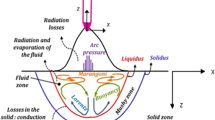Abstract
Weld pool fluid flow can affect the penetration of the resultant weld significantly. In this work, the computer simulation of weld pool fluid flow and its effect on weld penetration was carried out. Steady-state, 2-dimensional heat and fluid flow in stationary arc welds were computed, with three driving forces for fluid flow being considered: the buoyancy force, the electromagnetic force, and the surface tension gradient at the weld pool surface. The computer model developed agreed well with available analytical solutions and was consistent with weld convection phenomena experimentally observed by previous investigators and the authors. The relative importance of the influence of the three driving forces on fluid flow and weld penetration was evaluated, and the role of surface active agents was discussed. The effects of the thermal expansion coefficient of the liquid metal, the current density distribution in the workpiece, and the surface tension temperature coefficient of the liquid metal on weld pool fluid flow were demonstrated. Meanwhile, a new approach to free boundary problems involving simultaneous heat and fluid flow was developed, and the effort of computation was reduced significantly.
Similar content being viewed by others
References
R.A. Woods and D. R. Milner:Welding Journal, 1971, vol. 50, p. 163s.
C. R. Heiple and J. R. Roper:Welding Journal, 1982, vol. 61, p. 97s.
C.R. Heiple and J. R. Roper:Trends in Welding Research in the United States, S.A. David, ed., TMS, Metals Park, OH, 1982, p. 489.
B.C. Allen: inLiquid Metals— Chemistry and Physics, S.Z. Beer, ed., M. Dekker, Inc., New York, NY, 1972, chap. 4, pp. 161–212.
W. H.S. Lawson and H. W. KernWelding Research International, 1976, vol. 6, Paper No. 6.
C. Sozou and W. M. Pickering:J. Fluid Mech., 1976, vol. 73, part 4, p. 641.
J. G. Andrews and R. E. Crane:J. Fluid Mech., 1978, vol. 84, part 2, p. 281.
D. R. Atthey:J. Fluid Mech., 1980, vol. 98, part 4, p. 787.
G.M. Oreper, T. W. Eagar, and J. Szekely:Welding Journal, 1983, vol. 62, p. 307s.
C. Chan, J. Mazumder, and M. M. Chen:Metall. Trans. B, in press.
R.B. Bird, W. E. Stewart, and E. N. Lightfoot:Transport Phe- nomena, John Wiley, New York, NY, 1960, p. 79 and p. 314.
J. Szekely:Fluid Flow Phenomena in Metals Processing, Academic Press, New York, NY, 1979, p. 178.
W. F. Hughes and F. J. Young:The Electromagnetodynamics of Fluids, John Wiley, New York, NY, 1966, chap. 7, pp. 167–287.
J. D. Jackson:Classical Electrodynamics, 2nd ed., John Wiley, New York, NY, 1975, chap. 3, pp. 84–128.
N. S. Tsai: “Heat Flow in Arc Welding≓, Ph.D. Thesis, Massachusetts Institute of Technology, Cambridge, MA, 1983.
V. Pavelic, L. R. Tanbakuchi, O. A. Oyehara, and P. S. Myers:Weld- ing Journal, 1969, vol. 48, p. 295s.
E. Friedman: inNumerical Modeling of Manufacturing Processes, R. F. Jones, Jr., ed., ASME, New York, NY, 1977, p. 35.
S.S. Glickstein, E. Friedman, and W. Yensicavich:Welding Journal, 1975, vol. 54, p. 113s.
Y. Sharir, A. Grill, and J. Pelleg:Metall. Trans. B, 1980, vol. 11B, p. 257.
A. Grill:Metall. Trans. B, 1981, vol. 12B, p. 667.
S. Kou:Metall. Trans. A, 1981, vol. 12A, p. 2025.
S. Kou and Y. Le:Metall. Trans. A, 1983, vol. 14A, p. 2245.
O.H. Nestor:J. of Appl. Phys., 1962, vol. 33, p. 1638.
C. B. Shaw, Jr.:Welding Journal, 1980, vol. 59, p. 121s.
D. Rosenthal:Welding Journal, 1941, vol. 20, p. 220s.
S. V. Patankar and D. B. Spalding:International Journal of Heat and Mass Transfer, 1972, vol. 15, p. 1787.
S. V. Patankar and D. B. Spalding:Proc. 14th Symp. on Combustion, The Combustion Inst., Shefield, U.K., 1972, p. 605.
L. S. Caretto, A.D. Gosman, S.V. Patankar, and D. B. Spalding:Proc. 3rd Int. Conf. Num. Methods Fluid Dyn., Paris, France, 1972, vol. II, p. 60.
S. V. Patankar: inStudies in Convection: Theory, Measurement and Applications, B.E. Launder, ed., Academic Press, New York, NY, 1975, vol. 1.
F. H. Harlow and J.E. Welch:Phys. Fluids, 1965, vol. 8, p. 2182.
L. S. Caretto, R. M. Curr, and D. B. Spalding:Comp. Methods Appl. Mech. Eng., 1972, vol. 1, p. 39.
Aluminum Standards and Data, 5th ed., The Aluminum Association, New York, NY, 1976, p. 38 and p. 40.
Aluminum, K.R. Van Horn, ed., ASM, 1967, vol. I, chap. 1, pp. 1-30.
J.K. Brimacombe and F. Weinberg:Metall. Trans., 1972, vol. 3, p. 2298.
Author information
Authors and Affiliations
Rights and permissions
About this article
Cite this article
Kou, S., Sun, D.K. Fluid flow and weld penetration in stationary arc welds. Metall Trans A 16, 203–213 (1985). https://doi.org/10.1007/BF02815302
Received:
Issue Date:
DOI: https://doi.org/10.1007/BF02815302




